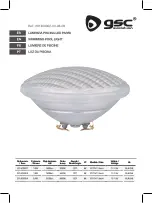
Page 18
In almost all cases where there has been a
temperature control failure in the heaters, the ther-
mistor probe has not been damaged. If the probe has
been tested and found to be okay, there is no need to
remove the draft hood or flue cap, and the top assem-
bly.
Disconnect the three different colored wires and
the two black wires from the back of the old tempera-
ture control.
Place the new unit in front of the control panel
opening and attach the two black wires and the three
colored wires. Be sure that the each colored wire is in
the same position on the new temperature control as it
was on the old.
Carefully seat the gasket. Secure the new control
panel to the front of the heater with the four screws.
Step Four
Ignition Control
If one lead from the voltmeter is attached to the
blue wire terminal on the transformer (that connects to
24V on the ignition control) and the other lead is
touched to the yellow/black 24V terminal on the
ignition control, and voltage registers, this indicates
that the safety controls, the temperature control, and
wire harness are not keeping the heater from firing (see
Fig. 26).
The following tests determine if the ignition
control is operating correctly. (Keep in mind that the
heater has a lockout ignition control. See Section 3C).
Before doing the electrical tests, make a visual check
of the ignition control components.
Pilot Burner.
Make sure it is positioned next to the
main burner (see Fig. 27), and there is no soot or dirt
on it.
Figure 26. Testing the Ignition Control
Figure 27. Pilot Location Dimensions
High Voltage Ignition Lead.
Connections must be
tight, and silicone rubber boots in place. Bare metal
parts of the high voltage ignition lead near the base of
the manifold bracket must be at least 9.6 mm from
other metal objects.
To test the ignition lead, position the control
panel switch to POOL or SPA and make sure the
temperature control knob is turned clockwise far
enough to call for heat. There will be a loud clicking
noise indicating the pilot electrode is sparking. If no
sparking is heard, pull the ignition lead from the
ignition control and hold the bare terminal 3 to 5 mm
from the ignition stud with a pair of insulated pliers
(see Fig. 28). If a spark does not jump the gap, replace
the ignition control.
NOTE:
The ignition control cannot be repaired in the
field. If it does not operate properly, replace it.
Figure 28. High Voltage Ignition Test
3-5 cm
1.1
2.65
18.6
30.5















































